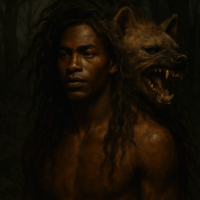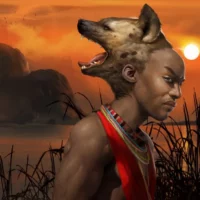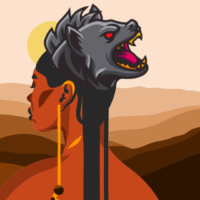Kishi : The Dual Faced One
Listen
At a glance
| Description | |
|---|---|
| Origin | Mbundu Mythology |
| Classification | Hybrids |
| Family Members | N/A |
| Region | Angola |
| Associated With | Shape Shifting, Cannibalism |
Kishi
Introduction
Kishi is one of the most striking figures in Angolan folklore, especially within the oral traditions of the Kimbundu people. This terrifying being represents the dangers of misplaced trust, seduction, and unchecked desire. Unlike many mythological spirits that dwell only in the realm of the unseen, Kishi is described in vivid detail, blending human beauty with predatory savagery. The tale of Kishi has been passed down for generations as a moral warning about the risks of judging by appearances and falling prey to charm without caution. Its story has endured because it embodies the constant tension between attraction and danger, a theme that resonates across cultures and centuries.
Physical Traits
The most infamous feature of the Kishi is its dual face. At the front, it presents the perfect image of male beauty—handsome, magnetic, and capable of drawing attention with ease. This facade is not simply cosmetic but serves as a deadly lure, designed to win the trust of unsuspecting victims. Concealed beneath its long, tangled hair, however, is its second face: the ferocious visage of a hyena. With powerful jaws lined with sharp teeth, the hyena face is capable of clamping down on prey with a grip that legends say cannot be broken.
Some stories expand on this duality, describing Kisihi as capable of supernatural regeneration, including the ability to grow back its severed head. In certain variations, the creature is not limited to one human face and one hyena face, but instead may appear with multiple heads or in alternate monstrous forms. These grotesque traits highlight its role as a predator that can never truly be escaped or deceived.
Family
The family connections of the Kishi reflect its disturbing nature. In some folktales, the Kishi is said to marry a woman while disguised in its human form. Once she gives birth, the creature reveals its true self and kills her, keeping the child to raise as its own. The offspring are described as two-headed beings, inheriting both the human and hyena traits of their father. Such children continue the cycle of predation, symbolizing how evil perpetuates itself across generations.
Kishi also appears collectively in certain legends, particularly in the story of Sudika-Mbambi, a cultural hero in Angolan lore. In this narrative, groups of Kishi, known as Makishi, are portrayed as destructive spirits responsible for slaughtering entire villages. This depiction emphasizes that the Kishi is not only an individual predator but part of a broader, menacing race of spirits that threaten human society.
Other names
The word Kishi has linguistic depth across Central Africa. In several Bantu languages spoken in Angola, the Democratic Republic of Congo, and Zambia, variations such as Nkishi and Mukisi mean “spirit.” These terms link the Kishi to a wider spiritual framework in which ancestral or supernatural beings intervene in human life, for good or ill. In some cultural contexts, nkishi can also refer to protective charms or spirit figures used in rituals, showing that the word itself has layered meanings depending on its use.
This dual linguistic function adds to the Kishi’s mystique. On one hand, the name represents a feared monster of Angolan mythology; on the other, it aligns with the broader Bantu concept of spirits that inhabit the world and shape human destiny. This fluidity makes the Kishi not only a localized legend but also part of a shared cultural imagination across the region.
Powers and Abilities
The Kishi is best remembered for its ability to deceive. Its human face is said to be unnaturally attractive, paired with smooth words and hypnotic charm that can disarm suspicion and lower a victim’s defenses. Once seduced, the prey becomes vulnerable to the sudden, violent attack of the hyena head. The jaws of this beast are described as unbreakable, locking onto flesh with lethal force.
Beyond physical danger, Kishi is credited with supernatural abilities. Some traditions describe it as a shape-shifter that can assume the form of a man, a hyena, or even a skull. In other tales, it possesses a “Stone of Power,” a magical object that allows it to absorb or block the abilities of other sorcerers. Its connection to fear is also emphasized—Kishi is believed to feed not just on human flesh but on the terror of its victims, gaining strength from their dread.
Despite its formidable powers, the Kishi is not invincible. Folklore suggests that fire and ritual magic can repel or weaken it. Ordinary weapons may also harm it, though few are said to have defeated the creature in direct combat. This vulnerability highlights the dual lesson of the myth: while danger is ever-present, courage and community defenses can provide protection.
Modern Day Influence
Although rooted in ancient tradition, the legend of Kishi has not faded into obscurity. In Angola, its story is still told as a warning against superficial judgment, reminding people that appearances can conceal hidden threats. The Kishi has also entered global awareness through literature and popular media. Antoine Bandele’s novel The Kishi explores the creature in a modern fantasy setting, reimagining it as a demon capable of moving undetected among ordinary people.
The symbolism of the two-faced spirit has taken on metaphorical power in contemporary discourse. The idea of someone who outwardly seems charming yet secretly harbors malicious intent resonates strongly in modern society, where the Kishi becomes a cultural shorthand for deceitful or predatory behavior. In academic studies, it is analyzed alongside other African spirits and demons as an example of how myths reflect social fears, particularly surrounding trust, sexuality, and predation.
Even in performance traditions, echoes of the Kishi survive. The makishi masquerades of Central Africa involve masked dancers embodying spiritual beings, including those associated with danger and duality. While not directly equated with the terrifying Kishi of folklore, the linguistic and symbolic overlap underscores how deeply the legend has permeated cultural expression.
Related Images
Source
Gods and Monsters. (n.d.). Kishi of Angola: Beautiful Face, Deadly Secret, Fierce Myth. Retrieved from https://godsandmonsters.info/kishi/
Spooklorepedia. (n.d.). Legend of Kishi: Unveiling the Myth and Mystery. Retrieved from https://spooklorepedia.com/territories/african-folklore/kishi/
Wikipedia contributors. (n.d.). Kishi (folklore). Wikipedia. Retrieved from https://en.wikipedia.org/wiki/Kishi_(Folklore)
Chatelain, H. (1894). Folk-tales of Angola: Fifty Tales, with Ki-mbundu Text, Literal English Translation, Introduction, and Notes. Boston and New York: American Folk-Lore Society.
Werner, A. (1933). Myths and Legends of the Bantu. Library of Alexandria.
Knappert, J. (1977). Bantu Myths and Other Tales. Brill Archive.
Frequently Asked Questions
What is lorem Ipsum?
I am text block. Click edit button to change this text. Lorem ipsum dolor sit amet, consectetur adipiscing elit. Ut elit tellus, luctus nec ullamcorper mattis, pulvinar dapibus leo.
What is lorem Ipsum?
I am text block. Click edit button to change this text. Lorem ipsum dolor sit amet, consectetur adipiscing elit. Ut elit tellus, luctus nec ullamcorper mattis, pulvinar dapibus leo.
What is lorem Ipsum?
I am text block. Click edit button to change this text. Lorem ipsum dolor sit amet, consectetur adipiscing elit. Ut elit tellus, luctus nec ullamcorper mattis, pulvinar dapibus leo.
What is lorem Ipsum?
I am text block. Click edit button to change this text. Lorem ipsum dolor sit amet, consectetur adipiscing elit. Ut elit tellus, luctus nec ullamcorper mattis, pulvinar dapibus leo.
What is lorem Ipsum?
I am text block. Click edit button to change this text. Lorem ipsum dolor sit amet, consectetur adipiscing elit. Ut elit tellus, luctus nec ullamcorper mattis, pulvinar dapibus leo.








